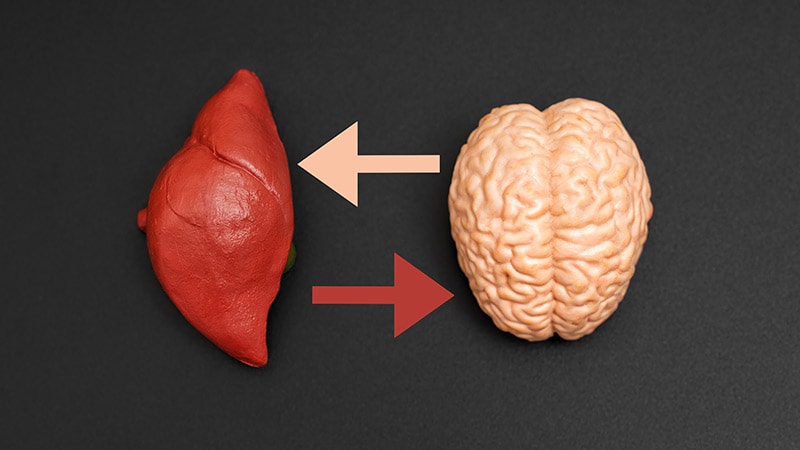Cirrhosis Misdiagnosed as Dementia in 13% of Cases: Importance of Screening with FIB-4 Index
Kernkonzepte
Patients diagnosed with dementia may actually have hepatic encephalopathy (HE) due to undiagnosed cirrhosis, which can be detected using the Fibrosis-4 (FIB-4) index.
Zusammenfassung
This study analyzed data from over 68,000 individuals diagnosed with dementia between 2009 and 2019. The key findings are:
- 12.8% of the dementia patients had a FIB-4 score > 2.67, and 7.6% had a score > 3.25, indicating the presence of advanced cirrhosis.
- Factors associated with a FIB-4 score > 3.25 included viral hepatitis, congestive heart failure, HIV, male gender, alcohol use disorder, and chronic kidney disease.
- The authors suggest that undiagnosed cirrhosis and potential hepatic encephalopathy (HE) can be a treatable cause or contributor to cognitive impairment in patients diagnosed with dementia.
- They recommend using the FIB-4 index as a screening tool to detect cirrhosis in patients with dementia, as this could lead to earlier diagnosis and treatment of the underlying liver condition.
- Incorporating the use of FIB-4 into screening guidelines, with input from various medical specialists, could help expand the diagnosis of cirrhosis and HE in dementia patients.
Zusammenfassung anpassen
Mit KI umschreiben
Zitate generieren
Quelle übersetzen
In eine andere Sprache
Mindmap erstellen
aus dem Quellinhalt
Quelle besuchen
www.medscape.com
Treatable Condition Misdiagnosed as Dementia in 13% of Cases
Statistiken
12.8% of dementia patients had a FIB-4 score > 2.67.
7.6% of dementia patients had a FIB-4 score > 3.25.
Factors associated with a FIB-4 score > 3.25 included viral hepatitis (OR 2.23), congestive heart failure (OR 1.73), HIV (OR 1.72), male gender (OR 1.42), alcohol use disorder (OR 1.39), and chronic kidney disease (OR 1.38).
Zitate
"We need to increase awareness that cirrhosis and related brain complications are common, silent, but treatable when found."
"Undiagnosed cirrhosis and potential hepatic encephalopathy can be a treatable cause of or contributor towards cognitive impairment in patients diagnosed with dementia."
Wichtige Erkenntnisse aus
by Marilynn Lar... um www.medscape.com 07-23-2024
https://www.medscape.com/viewarticle/treatable-condition-misdiagnosed-dementia-almost-13-cases-2024a1000dif
Tiefere Fragen
What are the potential barriers to the widespread adoption of the FIB-4 index as a screening tool for cirrhosis in dementia patients?
One potential barrier to the widespread adoption of the FIB-4 index as a screening tool for cirrhosis in dementia patients is the lack of awareness among healthcare providers about the association between cirrhosis and hepatic encephalopathy (HE) with dementia. Many clinicians may not routinely consider liver-related conditions when evaluating patients with cognitive impairment, leading to underutilization of tools like the FIB-4 index. Additionally, there may be challenges in integrating the FIB-4 index into existing dementia screening protocols or guidelines, which could hinder its routine use in clinical practice.
How can the differential diagnosis between dementia and hepatic encephalopathy be improved to ensure accurate identification of the underlying condition?
To improve the differential diagnosis between dementia and hepatic encephalopathy (HE) and ensure accurate identification of the underlying condition, clinicians should consider incorporating screening tools like the FIB-4 index into their assessment of patients with cognitive impairment. By routinely screening for cirrhosis in dementia patients, healthcare providers can identify individuals at risk for HE due to liver-related complications. Additionally, increasing awareness among healthcare professionals about the potential overlap between HE and dementia can help improve diagnostic accuracy. Collaboration between specialists in neurology, hepatology, and primary care can also facilitate a more comprehensive evaluation of patients presenting with cognitive decline.
What other medical conditions or comorbidities may also be misdiagnosed as dementia, and how can clinicians better recognize these alternative explanations for cognitive decline?
Apart from hepatic encephalopathy (HE), several other medical conditions or comorbidities may be misdiagnosed as dementia, including metabolic disorders, vitamin deficiencies, thyroid dysfunction, and neurodegenerative diseases. Clinicians can better recognize these alternative explanations for cognitive decline by conducting a thorough medical history, physical examination, and appropriate laboratory tests. Utilizing cognitive assessment tools, neuroimaging studies, and consultation with specialists in relevant fields can aid in differentiating between dementia and other conditions that mimic its symptoms. Moreover, interdisciplinary collaboration and regular follow-up assessments can help clinicians identify and address the underlying causes of cognitive impairment, leading to more accurate diagnoses and tailored treatment plans.
0
